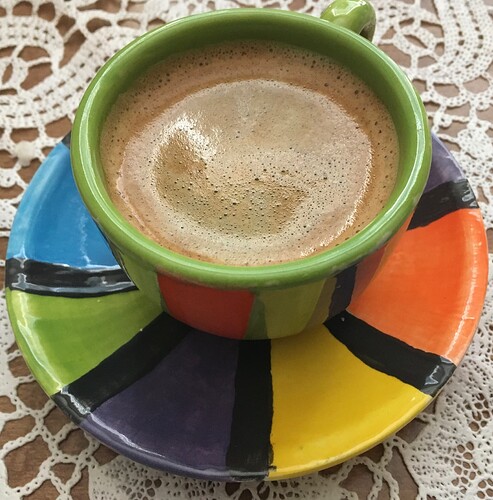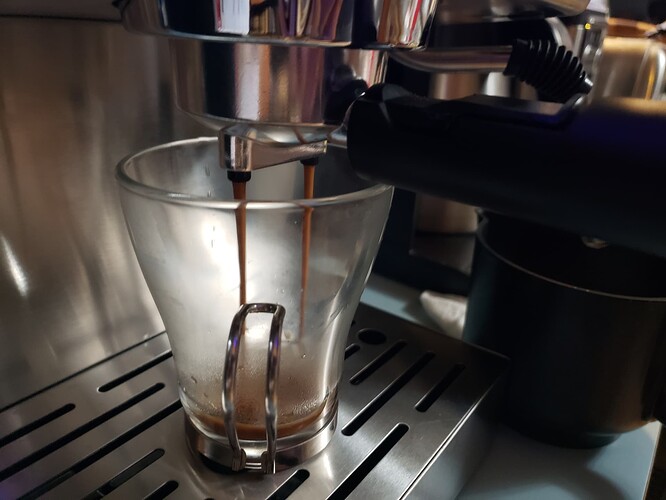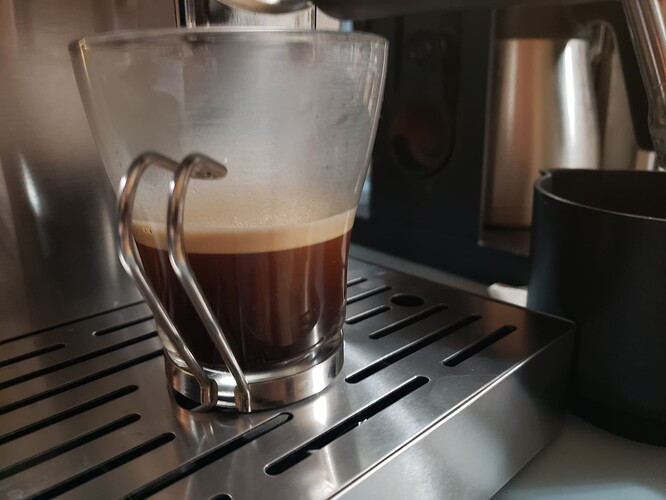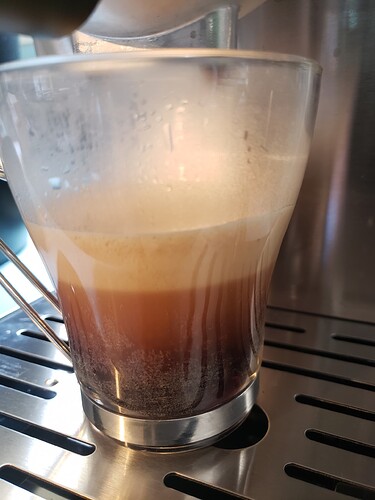Recent cup of Dolce. I prefer it over vita and it’s not very close.
After some experimentation, one thing I did notice is that extra droplets can drip off the side of the dropper if you don’t wipe it down. I set up the potassium to read in 10 ppm increments per drop and took the reading after each drop. At first it went as planned: 10 ppm, 20 ppm, 30 ppm. It was actually quite remarkable. Then on the fourth drop, I noticed that two smaller droplets leaped off the side of the glass, and the next reading was 58 ppm. Yikes. With good technique though, it seems like the alkalinity is fairly controllable; I have not yet had similar success with the hardness minerals.
Here’s the most practical “simple” application that I can see. I’m currently drinking a pink bourbon that’s awful at the normal 30-40 ppm alkalinity range. Bumping it up to 60-70 range rectified the weak and sour citrus acidity and delivered a beautiful coffee, and I achieved this by adding a few drops to the brewed coffee that I made with 40 ppm buffer. This is one of the situations where in the past I might have assumed that the problem was underextraction and never solved the bag. Having a method to instantly bump the buffer eliminates a lot of wasted time and coffee.
Interesting that it’s just the one dropper. I don’t have the equipment to test on my own. I do have an BlueAtHome thing from Leslie’s for testing pool water and it does measure alkalinity. I wonder if that would work…
In my experimentation so far, both of the hardness droppers are wildly inconsistent. It’s just that the calcium one is even worse than magnesium for some reason. Apparently the droppers for those release double the volume of the alkalinity droppers. This is all after I realized you need to wipe the sides down, hold it at about a 30 degree angle, and squeeze relatively quickly with medium pressure. If I do all of that magic touch bullshit perfectly then the alkalinity droppers are decently accurate and the hardness droppers vary considerably.

Is that a titration kit or like some kind of automated digital device?
Automated digital device. I syringe water into this testing disk, put the disk in the device, the device spins it and I get a report I can read on my phone
Sounds like it might use reagents but I can’t seem to find any accuracy claims for the device. Would be nice to know how accurate it is for total alkalinity. Looks like they claim that pool water should be between 80 ppm and 120 ppm, but some of these people on forums are saying this device “adjusts” the TA reading based on other values (pH and CYA). I dunno, seems like you could try it?
I’m not gonna dig my heels in too much on these findings yet since I’m not confident in the accuracy of my meter, although it did seem to be dead on with the alkalinity when the drops appeared to be correct size. An interesting thing I learned about the electrical conductivity measurement is that it’s governed by something called the Nernst-Einstein equation, and yes that’s Albert Einstein.
More Lotus water (my apologies). I’ve tested it more ways now and had success with consistency by dropping into larger volumes (900+ mL). However, the concentrations I’m getting are all double what is claimed by the product. For instance, the alkalinity drops are adding about 5 ppm and I’m more or less able to accurately predict what the reading will be for X number of drops (e.g., 8 drops reads about 40 ppm). Same thing for the hardness including the sodium, which, after some careful practice and wiping down of the dropper has resulted in fairly consistent readings, but it’s adding about 10 ppm into 900 mL according to my meter. My meter does not guarantee an accuracy that is meaningful in this range but I’m finding it difficult to believe that every reading taking over many drops would be off by exactly double the stated concentration.
I’ve been using a completely different brew method for a while now. I stopped blooming altogether and went to a two-pour structure like Patrik recommends at April. Sometimes three pours. You can check his methods but the key seems to be quickly and fully saturating all of the coffee with the first pour. For me that’s generally eight times the dry weight of the dose.
He makes a big conjecture that using the smallest (reasonable) dose maximizes this effect and therefore extraction uniformity, and it turns out to be about 12g. The reasoning is that it’s easier to fully saturate a smaller amount of coffee instantly and completely, and that this matters most at the very beginning where most of the important extraction is occurring. I’m not certain about this part yet. Dialing in 12g perfectly is tough after so many years living at 18-24.
It’s more complicated than that but the big first pour in place of the bloom is the major difference between what he’s doing and what I was doing. I’ll say that I definitely feel like it’s evened up my extractions and given me more complex cups with ease. Haven’t really had a sour one yet doing this but have overextracted quite a few of them. All of the usual parameters are still in play though and I’m still trying to develop a feel for those and how they interact with this method.
To simplify: the two things worth trying are (1) mini-dosing down to about 12g and (2) pouring 50% of the water in right away without blooming. The rest is normal parameters you’ll have to dial in to taste. It’s worth looking at if you’re currently struggling or just bored. Here’s one of the standard recipes:
Dose: 12g
Water: 200g at 91°C
Grind size: 9.2 (Ditting)
Brew time: 2:30-3:30
Target TDS: 1.25 - 1.35
Begin your brew with an initial 100g pour. Use your first 30g of the pour to saturate the coffee bed evenly whilst implementing a circular pouring technique. Continue your pour by completing the final 70g pour into the center of the coffee bed. Replicate this pouring format once again, commencing your second pour at 35 seconds. Finish the brew with a total brew time in 2:30-3:00 minutes.
Example of the pouring structure:
- 30g Circle Pour - 70g Center Pour (0:00)
- 30g Circle Pour - 70g Center Pour (0:30)
That’s designed for the April brewer but I’m having good results just using a V60 02 and adjusting the parameters. Other things that jump off the page are the temp (91 C / 196 F) and target particle size (920 um). The circle pour is high agitation / center pour is low agitation. That’s why default is 30/70 split but it’s one of the main parameters you’ll need to play with. Another point to consider is CO2 being a problem without blooming, so could make sense to grind 30 to 60 minutes prior to brewing.
Just about finished the bag of dolce. Really enjoyed it! Will probably grab a couple bags once I’m out of beans, and also add a couple of new ones from their sortiment.
@SvenO have you tried Espresso Club discord? They’re on top of emerging coffee industry stuff and probably have tons of trendy picks I’ve never heard of.
IIRC Patrik recommends grinding the night before into airtight vessels
Yeah that works too. Much more convenient.
I’d be interested to hear what you think about their single origin beans if you get around to trying them. Glad you liked the dolce. I get a great cup every time with it.
I once got distracted and forgot to bloom until almost halfway thru my pour and to my surprise it actually came out quite good! Could this be the reason why? I didn’t even know it was an option to skip the 30 second bloom process on a V60 pour over
Possibly but I think it’s “nobody really knows” territory. Blooming is conceptually similar to priming the pump since there’s generally a lot of CO2 trapped inside fresh coffee. You’re trying to get water into the coffee cells but if CO2 is simultaneously escaping then it might act as a force field and just push the water away leading to bypass. Another potential problem is that CO2 and H2O react to form carbonic acid, but it’s not clear to me if this happens to any meaningful degree in coffee brewing. And then finally independent of CO2, I seem to recall reading that presaturated material tends to give up dissolvable solids more easily than dry material.
To be clear though, when I say I’m “not blooming,” I’m talking about limiting the first pour to a volume that’s roughly only two to four times the dry weight of the coffee. Another way to think of it is blooming with a much larger volume of water because I’m still waiting about the same amount of time between pours. Whether the coffee you were brewing would significantly benefit from blooming would most likely depend on the roast level, freshness, and the time between grinding and brewing.
I have not! They’ll probably crucify me for not being accurate enough with my pull time, temp etc etc😂 I’ll check it out though! Maybe I’ll find some good bean recs
While I am nowhere near the level of some of you itt, I have just upped my coffee setup a little bit. My setup had been using a basic ninja brewer for my black coffee, and a nespresso OL machine for espresso/lattes (I know, ban me now).
Just grabbed a very basic espresso machine and have been enjoying the learning curve so far. First few pulls have been better than I was expecting. Most challenging part so far has been getting the milk right using the steaming wand. I had been using an auto frother jug with non dairy milk/creamer which works fine, but want to actually learn how to get the proper texture with while milk and steam. And tips?



